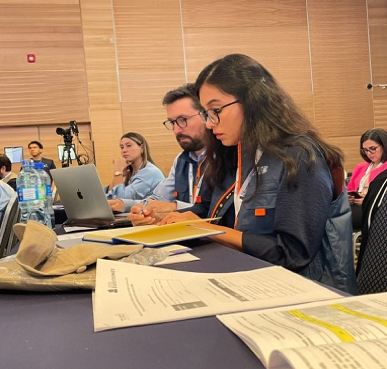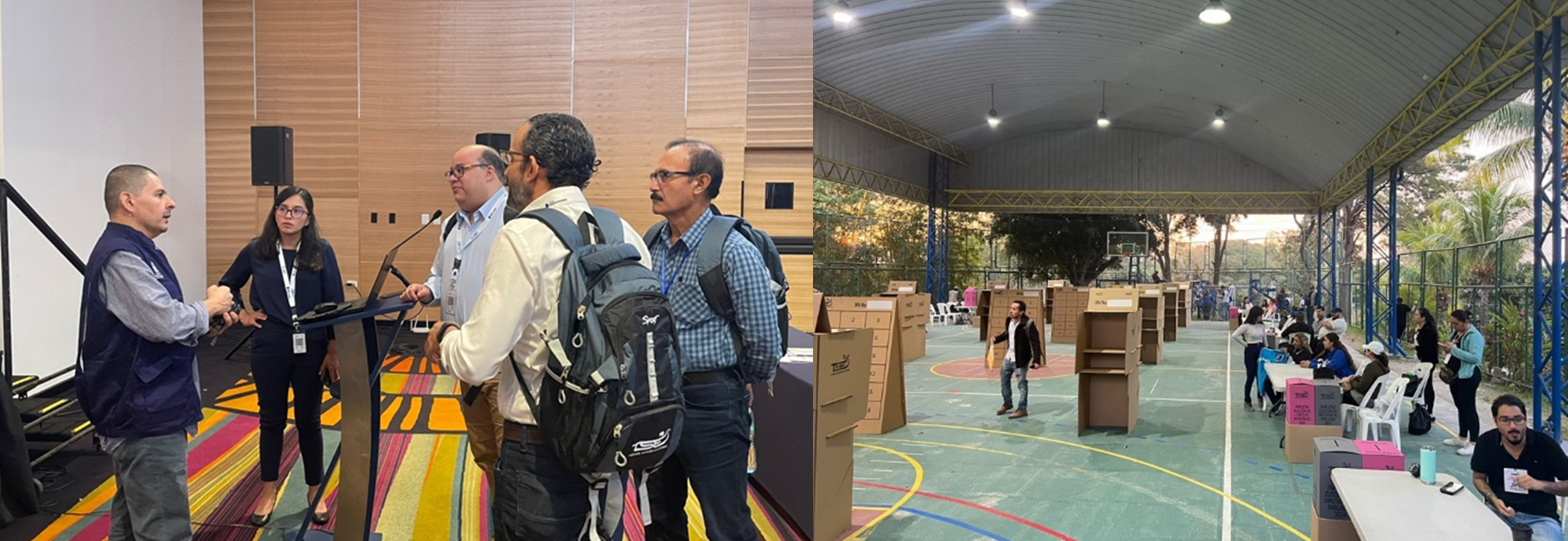| Experience as an international observer of the elections for members of local councils and PARLACEN in El Salvador 2024 |
|---|
| Last updated 2024-04-19 |
|
Written by Carla Cueva
Hidalgo Deputy Manager
of Training and Electoral Education/ Management of Electoral Organization and
Regional Coordination National
Office of Electoral Processes in Peru
As part of an invitation of the Tribunal Supremo Electoral (TSE) in El Salvador regarding the elections for members of local councils and PARLACEN 2024, the Association of World Election Bodies (A-WEB) extended an opportunity to participate as a member of the international observers’ mission to the National Office of Electoral Processes in Peru. Therefore, the mission comprised election officials and electoral experts from Guatemala, Belgium and Peru, alongside two representatives from the A-WEB Secretariat. The mission took place from March 1 to March 3, 2024, in El Salvador, spanning the capital and two other provinces.
During the predetermined period, the TSE hosted information sessions on the electoral operational plan, the legal framework, recent electoral reforms, the electoral transmission system and significant improvement actions. These sessions were conducted by experts from the TSE staff, who were readily available to address inquiries from the various electoral missions.
In addition, the A-WEB representatives served as a source of guidance and advice throughout the electoral mission. Thus, as a participant of the Election Visitor Program (EVP), I underwent a briefing session from A-WEB covering topics such as the local context, electoral procedures in El Salvador, including the installation of polling stations, the voting and counting process, an overview of the electoral transmission system, electoral materials and guidelines for electoral observation. This preparatory information was instrumental in facilitating comparisons with procedures in my own country, aiding in the identification of central points for electoral observation. Additionally, we revised an observer’s guide to apply the selected electoral observation methodology on election day, which was a useful tool to organize and register the stages of observation in each polling place, especially considering the number of activities co-occurring on election day.
Ultimately, these efforts contributed to a more complete comprehension of the electoral process in El Salvador.
Context and electoral characteristics
The elections for members of local councils and PARLACEN in El Salvador took place on March 3, 2024, barely one month after the presidential and legislative elections. This necessitated the Tribunal Supremo Electoral (TSE) to swiftly review and rectify any potential improvements, particularly regarding the digitalization and transmission system utilized post-counting. To address this, the TSE implemented a contingency plan with multiple stages, notably enhancing its staff training.
Review of positive aspects of the 2024 elections: members of local councils and PARLACEN in El Salvador
On election day, the observation route for the A-WEB mission spanned
three provinces, with seamless cooperation from the TSE staff within the
polling places and other field actors. The observer’s guide proved invaluable
throughout the day, facilitating the review and contrast of registered
information during debriefing sessions within the A-WEB mission. Here are some
noteworthy observations:
·
Voter
participation: the atmosphere within
polling places remained tranquil, with voters showing enthusiasm to cast their
ballots. Voting proceeded swiftly, and polling station members extended a warm
welcome to voters.
· Voting materials: despite variations in design and equipment across countries, the quality of voting materials was commendable and received in good condition. Particularly noteworthy was the design of the voting booth, adaptable for use in open spaces, allowing voters the option to sit or stand while casting their votes. Additionally, the use of ballot boxes in distinct colors minimized the likelihood of error when inserting ballots.
·
Training for
polling station members and materials: polling station members demonstrated proficient use of procedures,
especially during the installation of polling stations and the voting process.
This proficiency reflects the effectiveness of the electoral training provided
by the TSE, which was meticulously scheduled across provinces. The training
materials provided detailed, clear guidance on roles, election-day activities,
and management of special voting situations. Notably, the TSE developed diverse
materials promoting the electoral rights of people with disabilities, the LGBTQ
community, and senior citizens.
·
Counting
process: all observed polling
stations closed punctually, with only a small number of voters permitted to
cast ballots after 5 pm, as stipulated. The counting process proceeded
smoothly, with polling station members adhering to procedures and political
parties' representatives and national observers present.
·
Digitalization
and transmission system: the TSE
implemented a system where the polling station members could be the ones
registering the votes of the ballots and transmitting the results to the TSE.
In this sense, the materials and equipment appeared to be of good quality and
the personnel from the TSE demonstrated adequate training regarding technical
issues. Overall, this system's implementation promises improved citizen
services, including reduced transmission time to the TSE, expedited
digitalization processes, and scalable, innovative solutions. This underscores
the importance of logistical equipment deployment and ensuring nationwide TSE
staff coverage.
A final observation
As part of the A-WEB observation mission, we issued and delivered a report to the TSE with our final recommendations. Furthermore, it is important to acknowledge the TSE's effort to remedy certain observations made in the prior election, given the short amount of time between the two elections and the main goal of conducting the election as smoothly as possible.
Finally, I am grateful for the opportunity to have participated in this international electoral mission. Such international exchanges enable us to identify effective and pertinent electoral practices that could be implemented in our respective countries.
|

